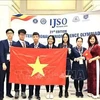For married artists Christiane Campioni and Tobias Kuester Campioni, Vietnam has always been an inspiration. But now it's also a home for them and their sons.
The couple said their family loved living in Vietnam. The country inspired them to invent an entirely new art technique, combining lacquer and metal.
In March, the Goethe Institute presented the Campionis' exhibition Harvest Moon. Large-format lacquer works on metal depicted the moon over the countryside and urban areas. Painting lacquer on metal made the paintings look bathed in moonlight.
During the harvest, the moon over Vietnam changes constantly, and has become a source of inspiration for the artists.
"In heat of the day, and in the midst of the dust and fires emanating from the rice harvest, the air keeps moving, causing the moon to look different," said Tobias.
The exhibition also displayed smaller paintings on Vietnam's life and culture.
Christiane inherited her love for Vietnam from her parents, who lived and worked in the Southeast Asian nation for several years.
Before graduating from the Dresden Academy of Fine Arts, where she studied conservation and restoration of art and cultural assets, Christiane chose to come to Vietnam on an internship. During her time here she learned about lacquer from veteran artists such as Le Kim My, Le Huy Van and Pham Chinh Trung.
She was eager to bring the technique back to Germany, and when she returned she set up a workshop. But her homeland's climate just wasn't suitable for preserving laquer paintings.
She met Tobias while in Vietnam, as he was a Dresden University of Technology architecture student visiting the country on a school trip. One year later the two came back to Vietnam to travel from North to South, and then tied the knot back in Germany.
In 2009, Tobias, who became an architect, encountered a small company in Uzbekistan that applied metal powder mixed with a bonding agent to wall surfaces, and after drying was ground and polished. It reminded him of his wife's passion for lacquer.
Christiane's interest in lacquer painting was re-awakened. They combined the metal powder method with traditional Vietnamese lacquer painting techniques. They utilised the metal powder to develop paintings and layered with inlays of eggshell, mother of pearl, bamboo and wood veneer.
The Campionis are the only ones in the world using liquid metal in this special way.
Christiane said when she lived in Hanoi for her internship she stayed with a host family close to the Ho Chi Minh Museum.
Everyday she rode her bicycle to the National Institute for Conservation and the University of Fine Art for lacquer classes. During this time, she had a chance to discover the Old Quarter and its goods: baskets, pottery, fabrics and craft stores that are featured in her paintings.
Thanks to her host mum, Christiane learned a lot about the ordinary lives of Vietnamese people and a little bit of the Vietnamese language.
Even when she returned to Germany, she still came to Vietnam every year to continue her studies in Vietnamese lacquer. Later, she and her husband decided to live in Vietnam and their children followed them.
"They make the combination between metal powder and materials that are familiar in Vietnamese lacquer, such as wood and mother of pearl," said Christiane's art teacher, painter Le Huy Van. "The effect is so incredible and expresses the harmony between Western and Eastern art."
The artists have applied the technique on decorative objects such as jewel boxes, mirror's frames and some kinds of furniture. In the near future, they will develop the production in Vietnam. "We want to be unique as long as possible, and for that we spent a lot of time on technical research to stay ahead of the curve and achieve attractive, timeless art and furniture," Christiane said.
For the couple, there is still more to discover in the fast-paced country. Vietnam inspired them because of its diversified culture, integration and development, Tobias said.
"In Vietnam, we saw changes during the years, the development and the new influences," he said.
"Every day in Vietnam gives us a little inspiration. It's the way bringing the kids to school on the motorbike, along the lakes. It's the morning fog over the lake and in the city. It's the crowded streets and the seeming chaos. It's the public market and all the exotic fruits. Last but not least, it's the lacquer."-VNA
The couple said their family loved living in Vietnam. The country inspired them to invent an entirely new art technique, combining lacquer and metal.
In March, the Goethe Institute presented the Campionis' exhibition Harvest Moon. Large-format lacquer works on metal depicted the moon over the countryside and urban areas. Painting lacquer on metal made the paintings look bathed in moonlight.
During the harvest, the moon over Vietnam changes constantly, and has become a source of inspiration for the artists.
"In heat of the day, and in the midst of the dust and fires emanating from the rice harvest, the air keeps moving, causing the moon to look different," said Tobias.
The exhibition also displayed smaller paintings on Vietnam's life and culture.
Christiane inherited her love for Vietnam from her parents, who lived and worked in the Southeast Asian nation for several years.
Before graduating from the Dresden Academy of Fine Arts, where she studied conservation and restoration of art and cultural assets, Christiane chose to come to Vietnam on an internship. During her time here she learned about lacquer from veteran artists such as Le Kim My, Le Huy Van and Pham Chinh Trung.
She was eager to bring the technique back to Germany, and when she returned she set up a workshop. But her homeland's climate just wasn't suitable for preserving laquer paintings.
She met Tobias while in Vietnam, as he was a Dresden University of Technology architecture student visiting the country on a school trip. One year later the two came back to Vietnam to travel from North to South, and then tied the knot back in Germany.
In 2009, Tobias, who became an architect, encountered a small company in Uzbekistan that applied metal powder mixed with a bonding agent to wall surfaces, and after drying was ground and polished. It reminded him of his wife's passion for lacquer.
Christiane's interest in lacquer painting was re-awakened. They combined the metal powder method with traditional Vietnamese lacquer painting techniques. They utilised the metal powder to develop paintings and layered with inlays of eggshell, mother of pearl, bamboo and wood veneer.
The Campionis are the only ones in the world using liquid metal in this special way.
Christiane said when she lived in Hanoi for her internship she stayed with a host family close to the Ho Chi Minh Museum.
Everyday she rode her bicycle to the National Institute for Conservation and the University of Fine Art for lacquer classes. During this time, she had a chance to discover the Old Quarter and its goods: baskets, pottery, fabrics and craft stores that are featured in her paintings.
Thanks to her host mum, Christiane learned a lot about the ordinary lives of Vietnamese people and a little bit of the Vietnamese language.
Even when she returned to Germany, she still came to Vietnam every year to continue her studies in Vietnamese lacquer. Later, she and her husband decided to live in Vietnam and their children followed them.
"They make the combination between metal powder and materials that are familiar in Vietnamese lacquer, such as wood and mother of pearl," said Christiane's art teacher, painter Le Huy Van. "The effect is so incredible and expresses the harmony between Western and Eastern art."
The artists have applied the technique on decorative objects such as jewel boxes, mirror's frames and some kinds of furniture. In the near future, they will develop the production in Vietnam. "We want to be unique as long as possible, and for that we spent a lot of time on technical research to stay ahead of the curve and achieve attractive, timeless art and furniture," Christiane said.
For the couple, there is still more to discover in the fast-paced country. Vietnam inspired them because of its diversified culture, integration and development, Tobias said.
"In Vietnam, we saw changes during the years, the development and the new influences," he said.
"Every day in Vietnam gives us a little inspiration. It's the way bringing the kids to school on the motorbike, along the lakes. It's the morning fog over the lake and in the city. It's the crowded streets and the seeming chaos. It's the public market and all the exotic fruits. Last but not least, it's the lacquer."-VNA



















